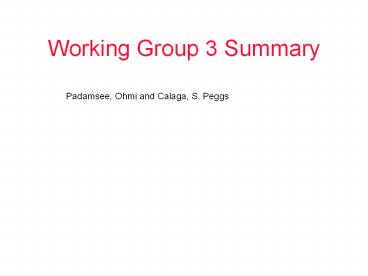Working Group 3 Summary - PowerPoint PPT Presentation
Title:
Working Group 3 Summary
Description:
Design crab cavity for these beam parameters. Layouts Discussed. Free space = 30 - 60 m ... 50 m free space !, 45 cm lateral. Most Advanced KEK - Three Damping ... – PowerPoint PPT presentation
Number of Views:31
Avg rating:3.0/5.0
Title: Working Group 3 Summary
1
Working Group 3 Summary
Padamsee, Ohmi and Calaga, S. Peggs
2
Design crab cavity for these beam parameters
3
Layouts Discussed
4
Free space 30 - 60 m
Lateral Space 45 cm ??
Small crossing angle (1 mr) does not work, need
more space
5
GuptaQuad Pairs for (not so) Large Crossing
Angle, 4mrad, why not 8 mrad?
Consider the two counter-rotating beams with the
first going through a quad. How close the
second beam can be?
It is 200 mm for the geometry on the right
Displaced quads with the first beam in the quad
and counter rotating beam just outside the coil
in a field free region.
Minimum X-ing angle is determined by how close
the other beamline can come
Might work for 800 MHz? Later
50 m free space !, 45 cm lateral
6
Most Advanced KEK - Three Damping Strategies
- Coaxial damper is very effective is damping TM010
mode (f 413 Mhz, MHz, Q lt 70), TE111 mode (f
650, 677 Mhz, Q lt 20 - Squashed cavity very effective in raising
frequency of unwanted TM110 from 500 MHz to 700
MHz I.e. above the cut-off frequency of large
beam pipe. - Large beam pipe removes all modes f gt 1 GHz
- Filling factor is low
- lt 0.1 m
- We need to come up with different concept with
larger filling factor - Multi-cells??
- Each HOM becomes n HOMs
- Trapped modes
7
(No Transcript)
8
Cavity Radial Size (43 cm)!!
9
KEK-B Cryomodule Size
1.5 m
10
Argonne ConceptSingle Cells, More Cells in
Cryomodule. Improve Filling Factor
Input coupler
Rejection filter
Qext - 1100
Power extraction from coax
Use 2-cells
11
LBNL Waveguide Damping Concepts
Q 2000
12
LBNL ConceptsMulti-cells, Waveguide Dampers
Waveguides to damp LOM, HOM and unwanted dipole
mode
- Q 1500, not lt 100
- One Monopole mode (0-mode) is trapped due to
cavity symmetry - Difficult to be damped either by coaxial insert
or waveguides in 3-cell - Consider asymmetry and larger beam pipes
13
2-Cell super-structure with damping
- Two 2-cell cavity with waveguide in between beam
pipe to damp unwanted dipole mode - Damping TE11 mode in beam pipe
- Effective in damping unwanted dipole mode
- The waveguide does not couple strongly with the
LOMs
- Waveguide near beam iris to damp unwanted dipole
mode (TM) directly - Strong damping on unwanted dipole mode
- Modest damping to LOM, 0 mode
Best Qs are still 1000
14
Open beam pipe to increase damping to Q 100
15
Tolerances and Other Issues
16
Sychro-Betatron Coupling Consequences
- Crab cavity causes an increase synchroton tune
(for Qx/y lt 0.5). Preset tunes 0.31 is OK. - Instabilities predicted above 1/2 integer
betatron tunes. Dispersion makes it worse, may
still be OK (Boaz). - With pair of crab cavities effect is reduced.
17
Tolerances at 1 mr and 400 MHz
Left-Right crab phase tolerance Zimmerman Df lt 0.012o (Dtlt0.08 ps) at qc1 mrad 400 MHz
Crab -acc cavity phase tolerance - Zimmerman Df lt 0.012o (Dtlt0.08 ps) at qc1 mrad 400 MHz
To keep emittance growth (due to random offsets) lt 10/hr Df lt 0.008o at qc1 mrad 400 MHz
Ohmi - strong-strong simulation, lumi- lifetime 1 day (white noise) Df lt 0.0015o at qc1 mrad 400 MHz
Kick voltage Jitter tolerance - Zimmerman 0.1
18
(No Transcript)
19
Compare to ILC
20
(No Transcript)
21
Field and Phase Stability RequirementsFor
Near-Future Projects
From Matthias Liepe, Cornell, PAC 05
- Different accelerators have different
requirements for field stability! - approximate RMS requirements
- 1 for amplitude and 1 deg for phase (storage
rings, SNS, JPARK) - 0.1 for amplitude and 0.1 deg for phase (linear
collider, LCLS) - down to 0.01 for amplitude and 0.01 deg for
phase (XFEL, ERL light sources)
22
Example Digital I/Q Control
Vector Modulator
Klystron
Master Oscillator
?
90
X
?
X
0
Icontrol
Cavity
Qcontrol
Imeas, Qmeas
DSP/ FPGA
DAC
ADC
DAC
IF
RF
LO
X
Down Converter
23
LLRF for J-PARC (KEK)
- LLRF system for pulsed n.c. proton linac of
J-PARC - FPGA based I / Q control
- Field stability exceeds specs (1 in amplitude
and 1 degree in phase ) - Base for STF LLRF system
MixerI/Q
DSP/FPGA
0.08
0.04 deg
S. Michizono et al.
Shown for absolute phase
24
Cornell LLRF System for ERL operation at QL
1.2?108
Very good field stability demonstrated with 5 mA
beam
?A/A ? 110 - 4
12.4
12.3
accelerating field MV/m
12.2
12.1
0
0.2
0.4
0.6
0.8
1
time sec
11
?? ? 0.02 deg
10.5
10
phase deg
9.5
9
0
0.2
0.4
0.6
0.8
1
time sec
How much better can we do for relative cav-cav
relative phase ??
25
Upcoming Test
26
(No Transcript)
27
Final Recommendations
- Size calibration Crab mode at 400 MHz means
fundamental TM010 mode is at 259 MHzouch ! - Take a very hard look at 800 MHz, is emittance
growth due to non-linearity of RF acceptable? - Use R12 45 m gt V 37 MV for 8 mrad
- Use advanced gradient 10 MV/m
- Active length 3.7 m x 4 (regions)
- Filling factor 0.3 gt 12 m
- Phase tolerance is x2 more relaxed.
28
Can This Work (Maybe 2 Cavities if necessary)
Forward beam
RF Cavity TM010
Dampers
Dampers
Return Beam
29
Advantages
- TM010 is the Lowest Order Mode in the Cavity
- No Degenerate Mode to Worry about
- Damping HOMs easier
- Easier manufacturing
- Will the longitudinal E field cause a problem ??































